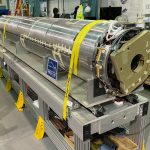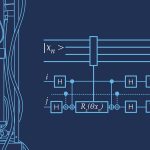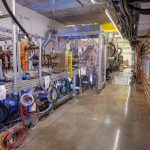The U.S. Department of Energy has given the U.S. High-Luminosity Large Hadron Collider Accelerator Upgrade Project approval to move full-speed-ahead in building and delivering components for the HL-LHC, specifically, cutting-edge magnets and accelerator cavities that will enable more rapid-fire collisions at the collider. The collider upgrades will allow physicists to study particles such as the Higgs boson in greater detail and reveal rare new physics phenomena. The U.S. collaborators on the project may now move into production mode.
accelerator technology
From CERN Courier, Jan. 13, 2021: The US LHC Accelerator Upgrade Project, led by Fermilab scientist Giorgio Apollinari, is now entering the production phase in the construction of magnets for the upcoming High-Luminosity LHC, an upgrade of the current Large Hadron Collider. U.S. labs are building magnets that will focus beams near the ATLAS and CMS particle detectors.
From APS Physics, Dec. 4, 2020: Scientists are finding ways to increase particle accelerator efficiency. One way to reduce cooling costs relies on a technique developed at Fermilab and Jefferson Lab.
From Jefferson Lab, Nov. 20, 2020: Thomas Jefferson National Accelerator Facility has shipped the final new section of accelerator that it has built for an upgrade of the Linac Coherent Light Source. The section of accelerator, called a cryomodule, has begun a cross-country road trip to SLAC National Accelerator Laboratory, where it will be installed in LCLS-II, the world’s brightest X-ray laser. The upgraded LCLS will boast 37 cryomodules in total. Of those, 18 are from Jefferson Lab (plus three spares), and the rest will come from Fermilab.
From CERN Courier, Nov. 10, 2020: Established 30 years ago with a linear electron-positron collider in mind, the TESLA Technology Collaboration has played a major role in the development of superconducting radio-frequency cavities and related technologies for a wide variety of applications. The first decade of the 21st century saw the TTC broaden its reach, for example, gradually opening to the community working on proton superconducting cavities, such as the half-wave resonator string collaboratively developed at Argonne National Lab and now destined for use in PIP-II at Fermilab.
From Interactions.org, Nov. 9, 2020: Large-scale accelerator facilities around the world, such as Fermilab and the Japan Proton Accelerator Research Complex, send near-light-speed proton beams into pieces of material called a target. The collision produces other particles, which scientists study to learn the fundamental constituents of matter. The RaDIATE collaboration has published new results on a target material made of a titanium alloy, shedding light on how different titanium materials respond to collisions by powerful proton beams.
On Oct. 21, the PIP-II Injector Test Facility accelerated proton beam through its superconducting section for the first time. At this test bed for the upcoming PIP-II superconducting accelerator, collaborators will test novel particle accelerator physics concepts and technologies to be deployed in the high-tech front section of PIP-II, the future heart of the laboratory accelerator complex. The milestone achievement also marks the start of a new era at Fermilab of proton beam delivery using superconducting accelerators.
From Tech Briefs, Oct. 1, 2020: Fermilab has developed a high-power, high-energy, superconducting radio-frequency electron gun for advanced metal additive manufacturing applications. The novel design is based on a technique that eliminates liquid helium entirely and dramatically reduces the complexity of the system.
From University of Wisconsin-Madison, Sept. 28, 2020: Getting blasted with proton beams takes a toll on accelerator targets. As researchers begin to consider upgrading existing accelerators and building more powerful models, the durability of those devices is a major concern. University scientists are working with Fermilab in a new collaboration to study and improve the durability of targets and target windows, which will be important for neutrino experiments such as the international Deep Underground Neutrino Experiment, hosted by Fermilab.



